Background
This is my thesis project in architecture from 2019, which was located in Hall Prison Facility – a level 1-security prison located outside Södertälje.
The fundamental idea was to make an extension at the site, with the original conditions considered, to improve the daily life for the inmates. To come to this conclusion, I was using the design thinking-method.
Historical timeline of prisons

Level 1 Prisons

What is the purpose of prison?
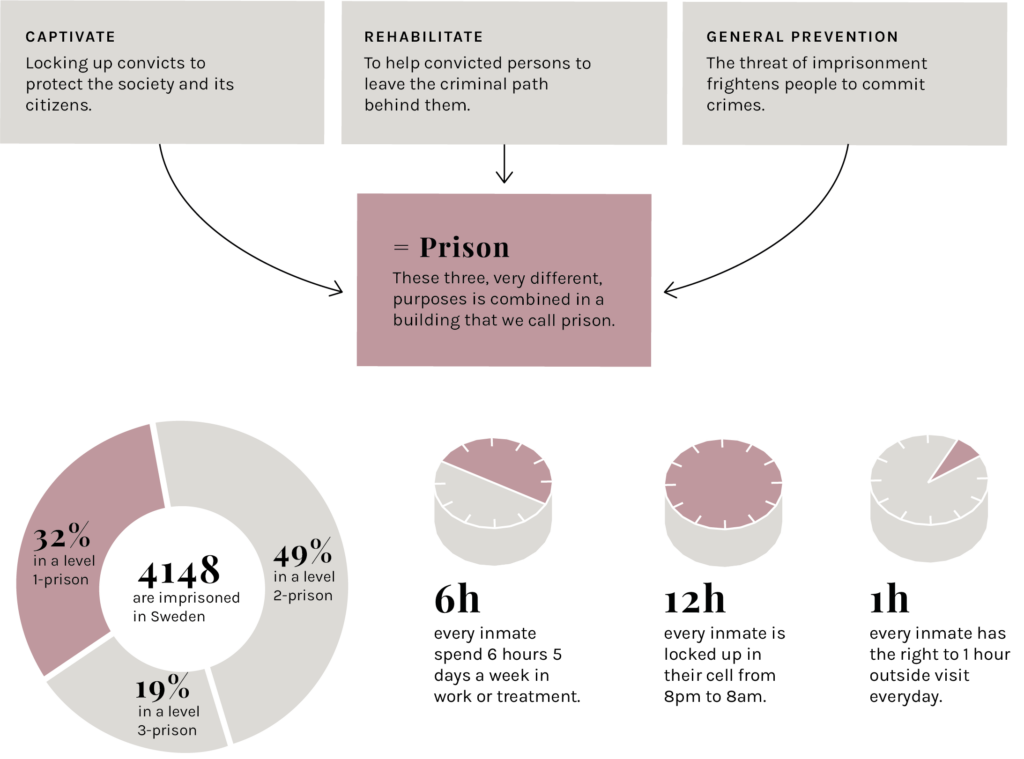
Method
1. Empathize
During this part I got to know Hall and the users. Hall was not the most accessible site to research – after a lot of back and forth I was allowed to visit the prison and a prison department inside Hall.
Hall prison facility
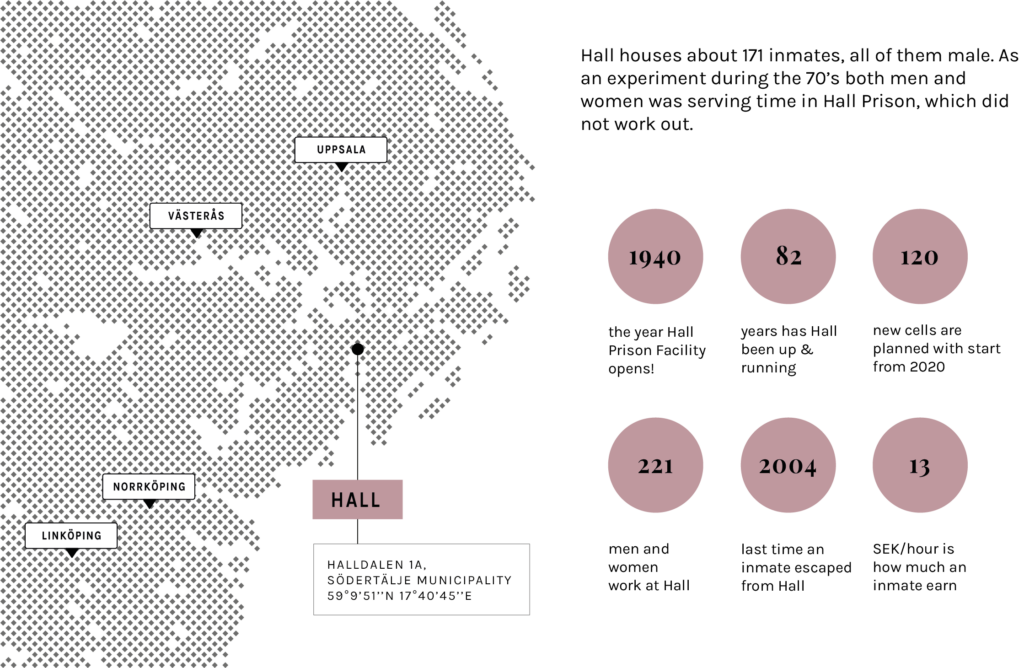
Users
Through several site visits, interviews and research I mapped the users of the prison Hall. When you think about who uses a prison, you naturally think about the inmates. During the empathize phase I discovered there are more people involved – the inmates’ relatives that are visiting, and of course people who work in the prison facility.
Has been to prison 7 times,
6 times in Syria and 1 time in Sweden Level 1 prisons or similar
”People relapse into crime because they have nothing outside. When you finish your sentence, most people have nowhere to go. No apartment, no job. A prison sentence is hard on a relationship, most likely you don’t have a partner either. You have lost contact with a lot of your friends. You end up on the street. And on the street there are drugs and then you’re back to square one. ”
Has been to prison 8 times
In Sweden, Denmark & Turkey Level 1 & 2-prisons or similar
”My girlfriend at the time visited me in prison, but not my children. I didn’t want them to see me in that environment, broken in a ”kriminalvården-costume”.
The visitor’s room was very claustrophobic, even for me. I couldn’t let them be locked up in that room. I decided not to meet them during my last sentence, which lasted for 1 year and 7 months. They still think that I was away working.”
Grew up with a parent in prison
The parent was sentenced to life
”My dad called life outside prison ”the free world”. His recipe was to stay in contact with the free world, to survive being locked up. He told me that some people shut down the free world, because it was easier. But inside prison there was nothing. It wasn’t uncommon that his prison friends got mentally ill.”
Have kids with an ex-inmate
Her partner’s last sentence lasted a year
”Visiting a prison makes you feel as criminal as you were the one being locked up. Children shouldn’t be punished because their dad screwed up and got himself to prison. The first visits lasted 40 minutes in a tiny room on a dirty sofa. It’s very hard to believe that the prison cares about the children, the sympathy is definitely lacking. ”
Correctional inspector at Hall
Have been working in the Swedish prison establishment for 15 years
”Rehabilitation is the most important part of our work. The inmates shouldn’t be here just to do time, we really want them to end their sentence with the feeling that they have become ”better out” (Kriminalvårdens motto). Which, on the other hand, is one of the biggest challenges here.”
Worked as a prison warden during her period of studies
Lawyer specialized in criminal law
”The Kriminalvården environment is not famous for being cozy. There are big metal doors, metal detectors, locks everywhere, and assault alarms. Safety is the main thing, even though there are some half-hearted attempts to make it child-friendly. But at the end of the day, we can’t compromise with safety.”
2. Define
What was the actual problem that I was trying to solve? Although prison is a traditional system of punishing and lecturing criminals, the system does not seem to be working. The problem is – even though criminals serve their sentences, they still relapse into crime when they get back into society.
Why do inmates relapse into crime?
Since 55% relapse into crime after they have served a prison sentence, the considerable effect of prison is questionable.
Scientists argue that people do not relapse into crime randomly – there are different patterns to find depending on which factors you study. There are of course countless theories about why ex-inmates relapse into crime, depending on who you ask. One widely accepted theory is ”The central eight theory”, which became the theory that my project was based on.

The central eight theory
“The central eight”-theory is developed by Andrews and Bonta and is based on the “Risk-Need-Responsivity”-model, which was developed in the 1980s during the “nothing works”-pressism around rehabilitation in prison.
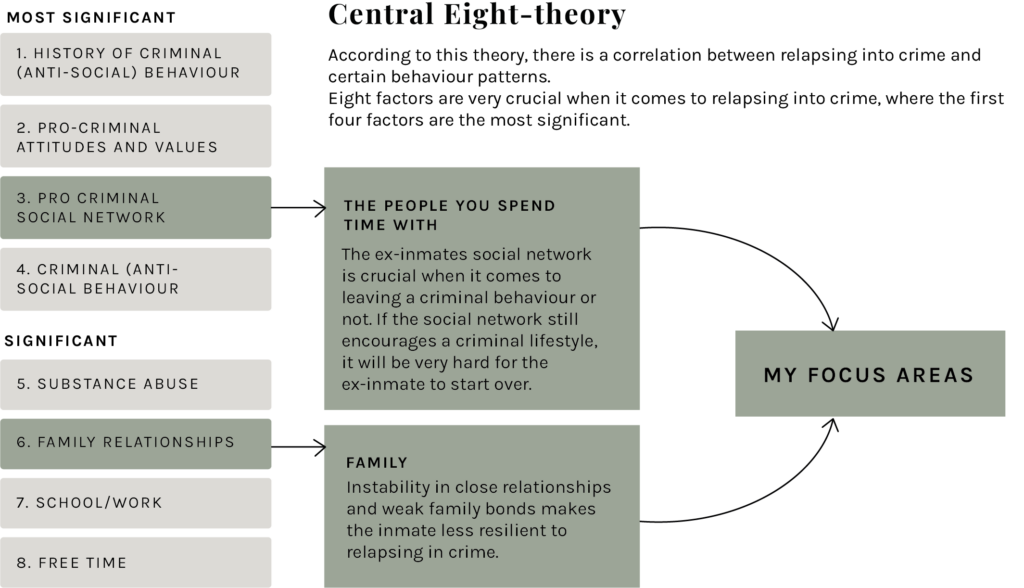
Visiting a prison
As I stated in my focus areas, contact with the outside world and family network is crucial for not relapsing into crime. To improve the inmate’s contact with the outside world, I first needed to understand how the contact with relatives outside prison looked like.


3. Ideation
I asked how I might improve the way inmates meet their families and friends. I looked at the current visiting process at Hall today to see what could be different.
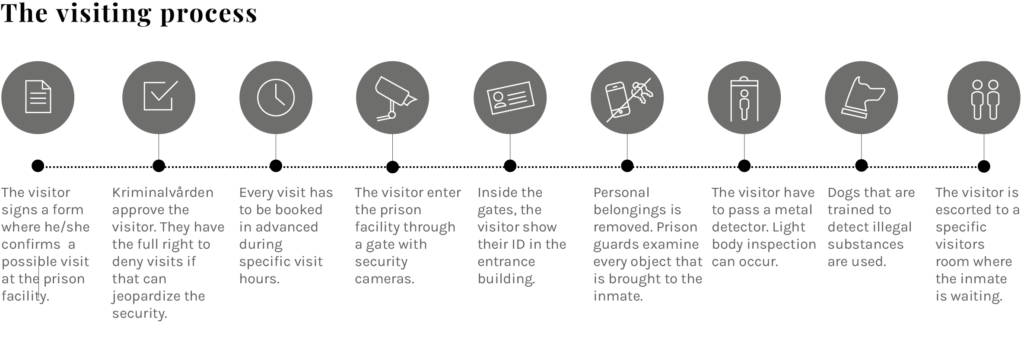
The current visitor’s room
Hall has 16 different visitors room where the inmates can spend time with their family and friends. The prison facility also has a special apartment for families.
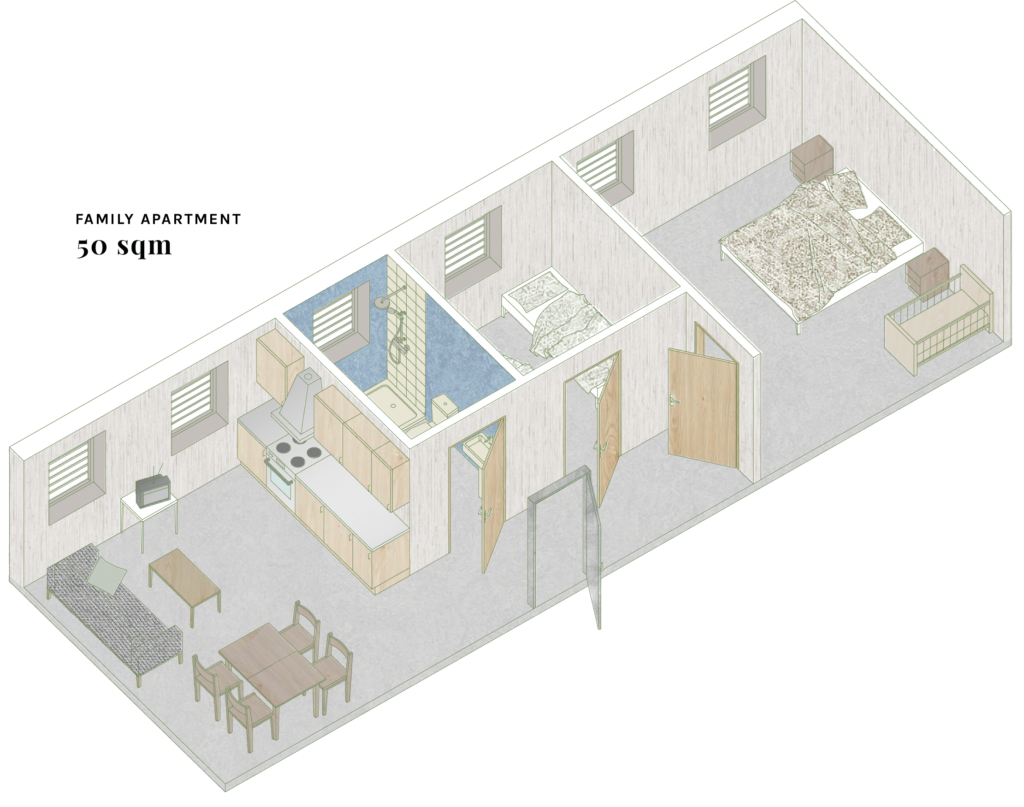
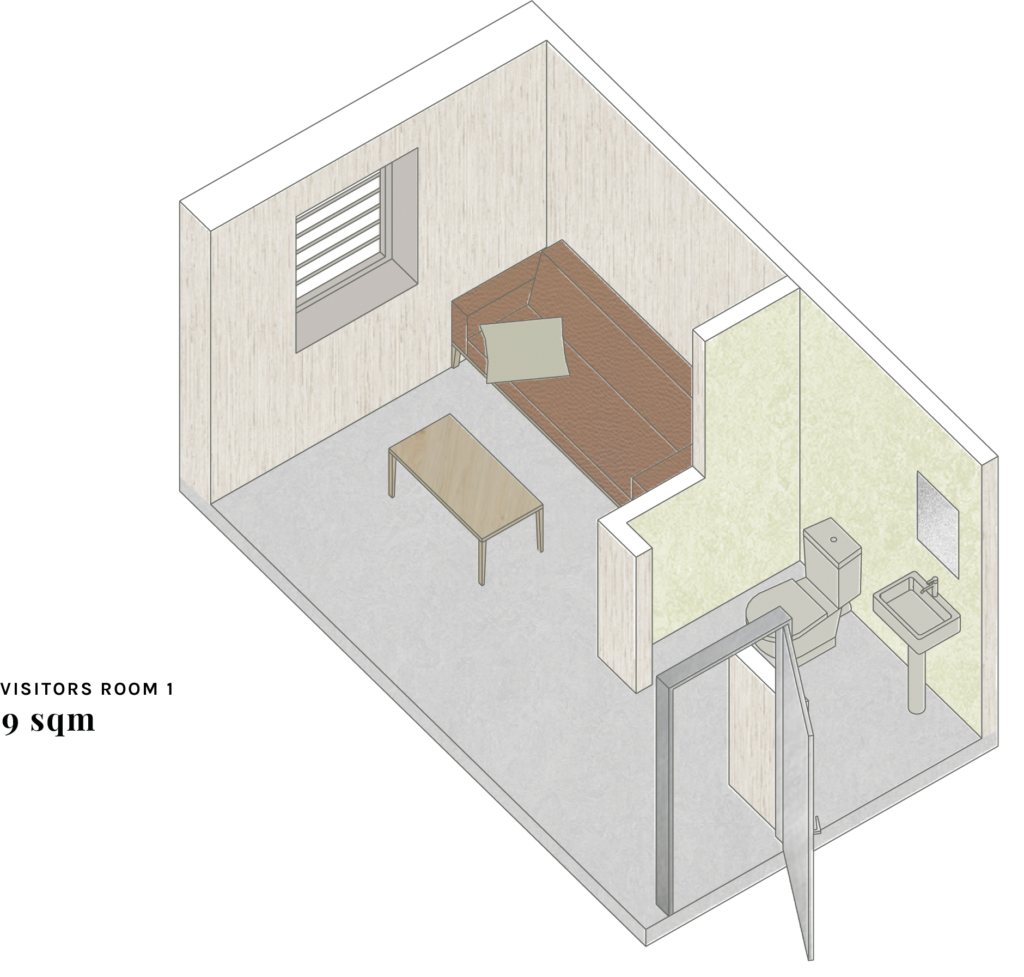
Permissions
To be allowed to go on permission it requires that you have served at least 25% of your sentence. Permission can last for a couple of hours but a maximum of three days. This means that the existing visiting rooms in the prison facility still will be in use, for the inmates that are at the beginning of their term of punishment.
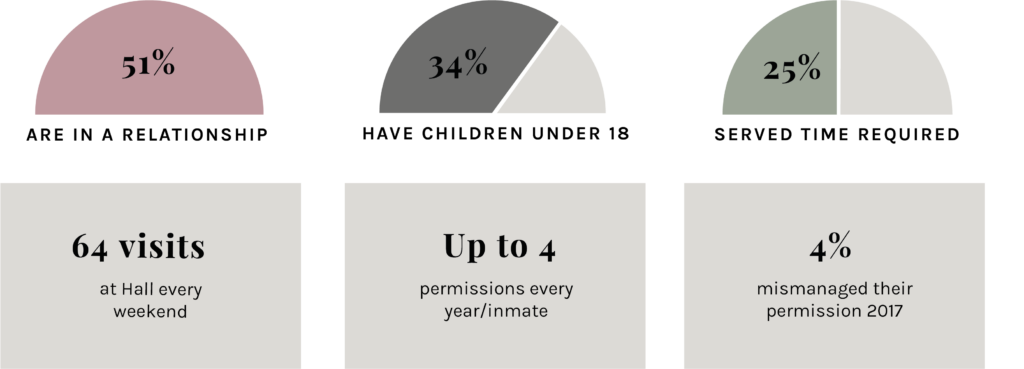
Programme
After mapping out what the visiting process and facilities looked like, the next step was to see what was working and what was missing. The central question in this process was how architecture could improve the connection between the prison world and the world outside. What could that architecture contain, and what did it have to contain due to the architecture being a prison?
Based on my research, interviews with the users and site visits, I started to concretize the different blocks needed in my project.
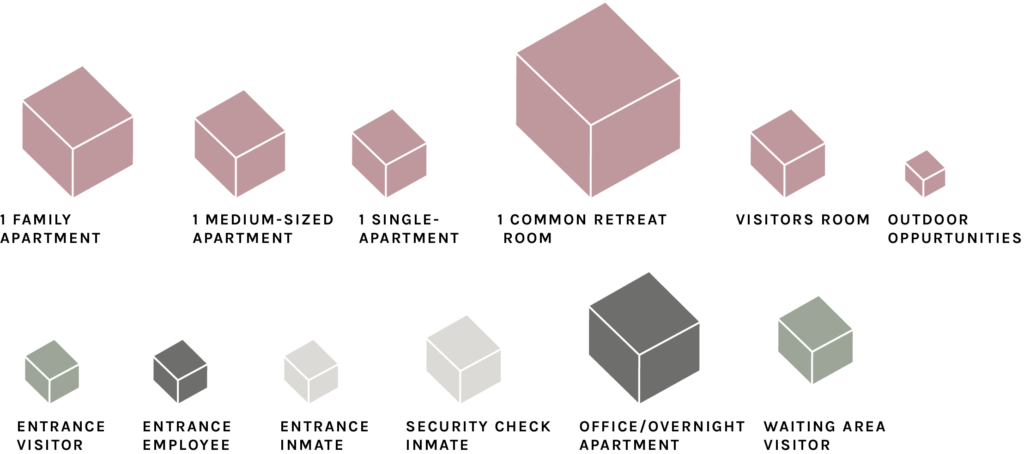
4. Prototype
At this point, it was clear that there was room for architectural improvement when it came to visiting a prison. But there were still many questions left unanswered. How would the inmates be transported to the building? Did the visitors need to go through a security check? How could the employees reach this building? Which materials would be most suitable in the context?
It was not only due to the strict security measures in a prison environment that the building needed to have separate entrances for the different users. The visiting families and friends need to be greeted by a building that didn’t feel like a prison. At the same time, the inmates needed to be able to be transported to the building from the other facilities in Hall. The staff also needed to be able to have a safe working environment.
My solution was an entrance for the visitors with a beautiful view to take away the feeling of being locked up. An underground culvert with a connected security check was used for the inmates. The staff had a separate entrance on the back side of the building with a separate parking lot so they were able to come and go to work safely.
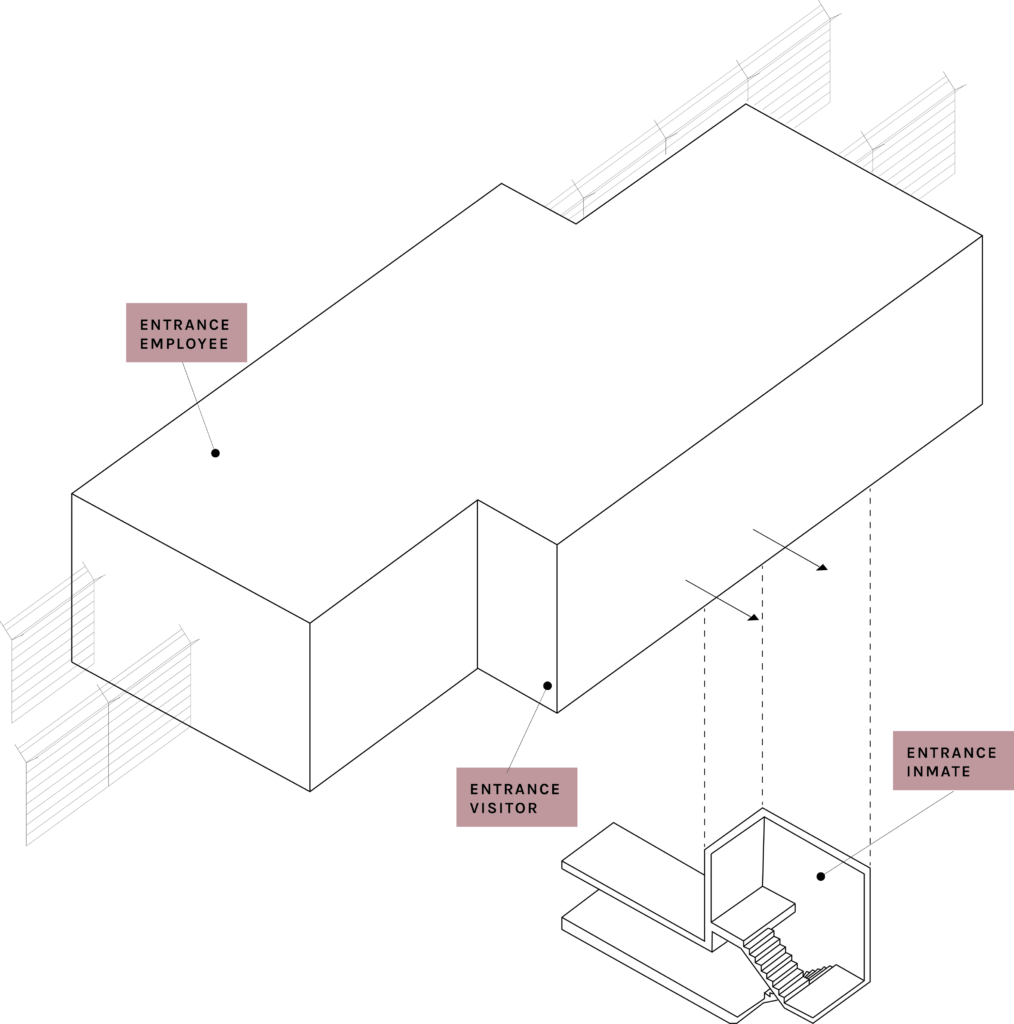
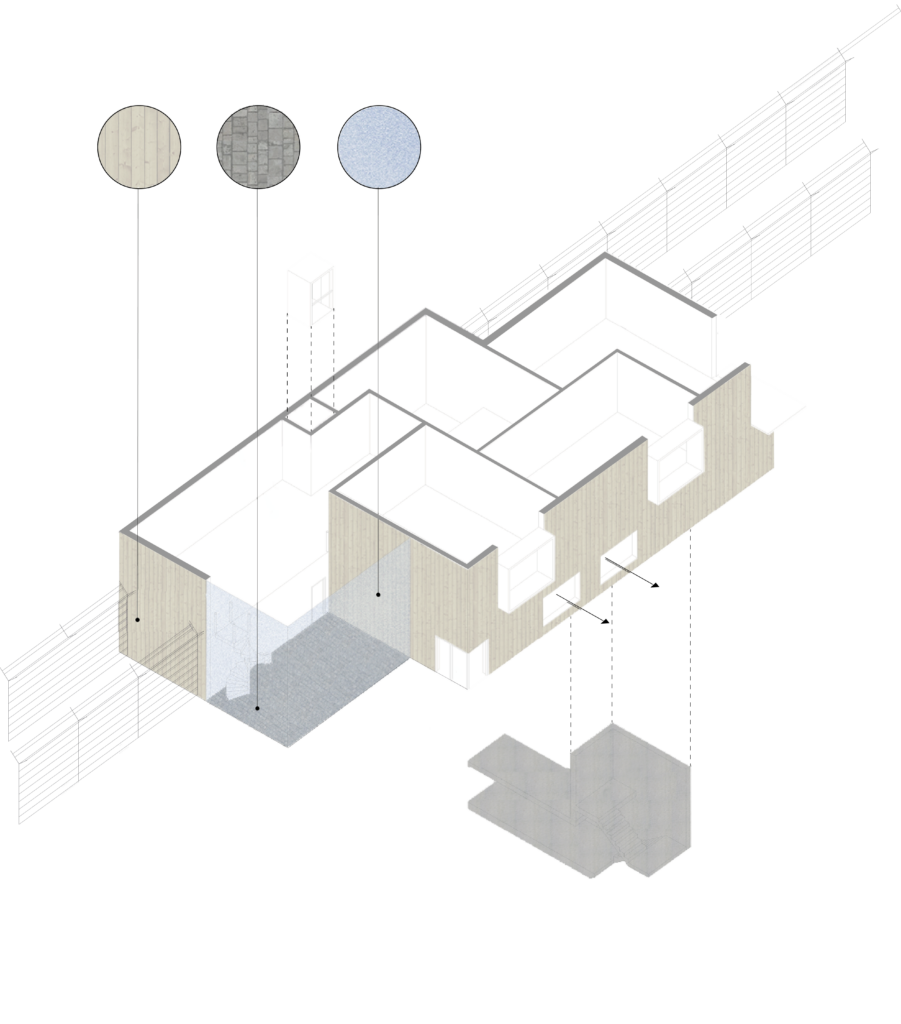
Response
When I started this project I didn’t know much about the Swedish prison system. And, as my supervisor told me, my approach to this complex matter had become softer as the project went on.
I understood that prison is more than just locking up criminals. Most of the inmates have relatives – who of course also will suffer from the inmate’s imprisonment. Considering that 60% of the inmates have a parent that also has been to prison, the family definitely plays a significant role.
To test my ideas, I interviewed the users that I identified during the first phase.
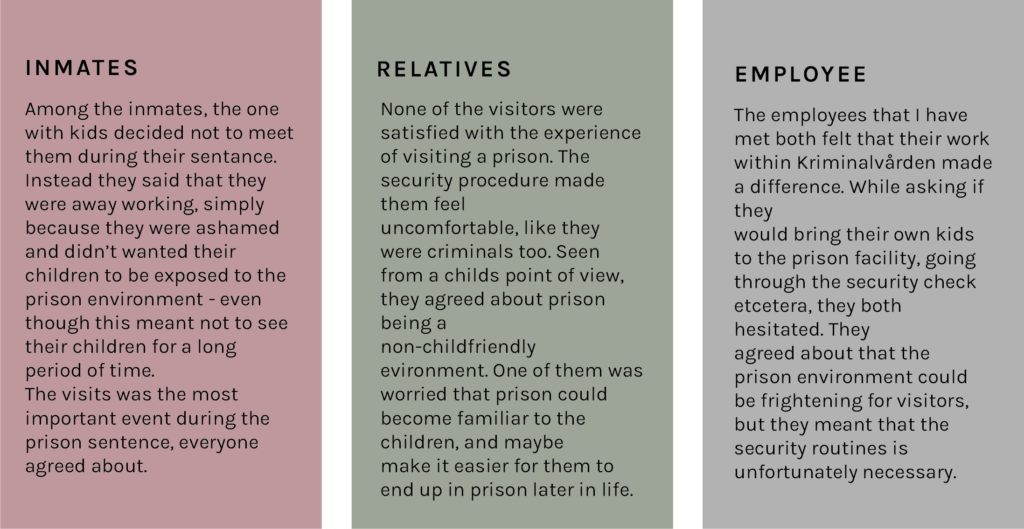
5. Final phase
This visitors building is placed between the two outer fences and is classified as a building for semi-permissions. This meant that the building would have lower safety requirements than the rest of the prison facility. The visitors had to be cleared by Kriminalvården and book their visit in advance.
Upon arrival, the visitors would not go through any security check except for showing id, while the inmates would go through the security check before entering and leaving the building.
Hall prison facility map
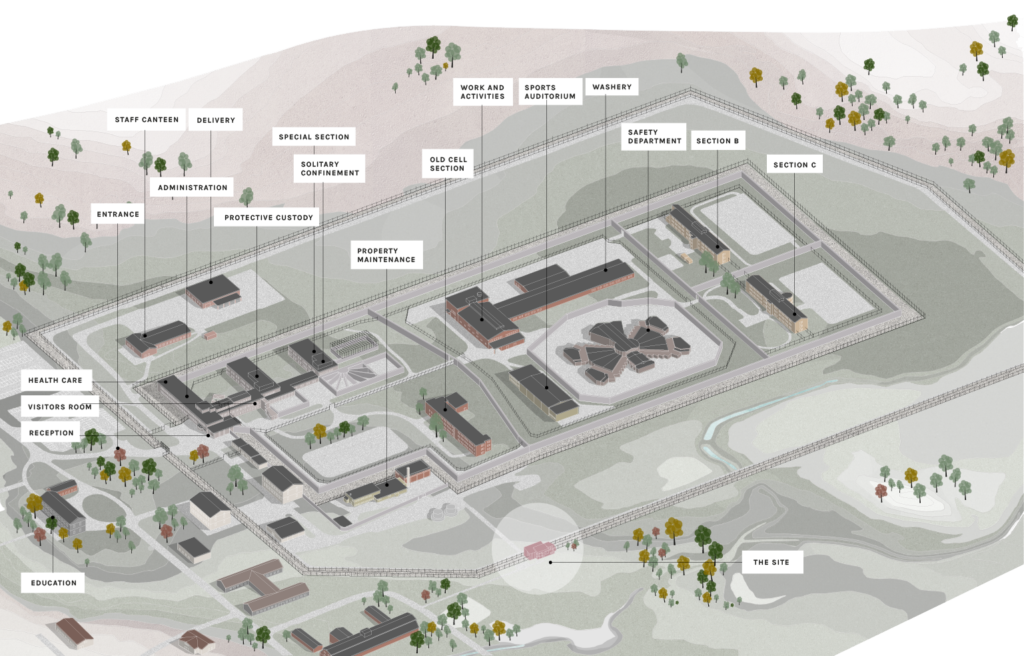
Hall Siteplan 1:1000

Exterior
The building had two stories, like most other buildings within the prison facility. But instead of concrete and plaster, the building had a wooden facade combined with glass.
Since the building was still located in the prison facility, the ambition was not to lie about the building being a prison extension. The ambition was rather to put a part of the outside world inside the prison world. I wanted to create a normal space in an abnormal situation. Based on the exterior alone, and placed in a different location, this building could have been anything but a prison.
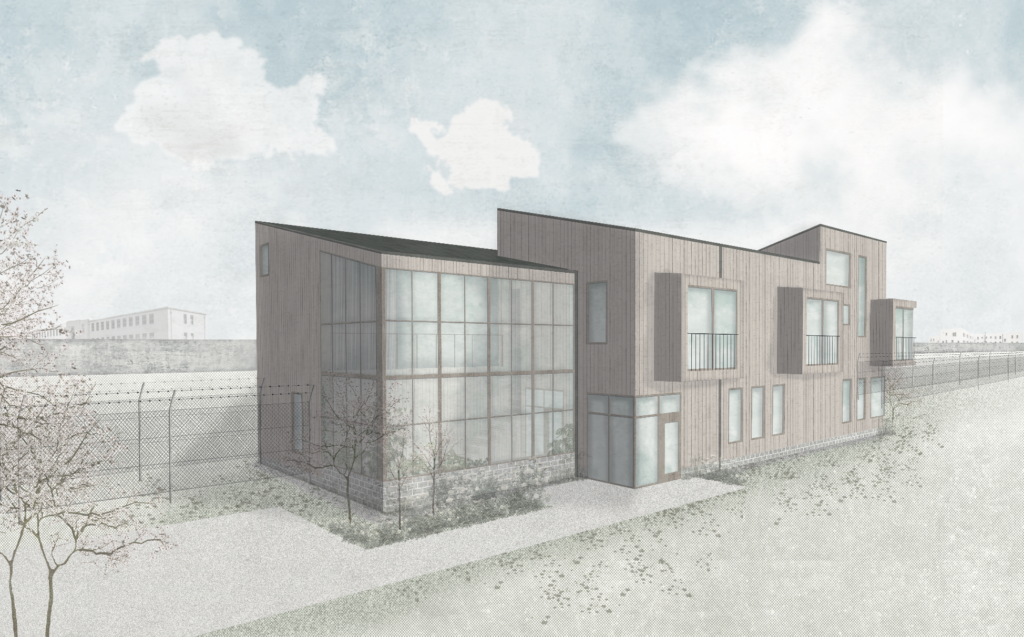
Family apartment
There were three apartments on the second floor, with different layouts based on the various constellations. I wanted this family apartment to feel spacious and light. My aim was to create a space to be together, to do normal things such as cooking, watching tv and playing games, but also spaces to be on your own. Based on user interviews, these things were not only what the inmates missed the most while being locked up, but also what the visitors thought was most important to add to make their visits feel more normal.
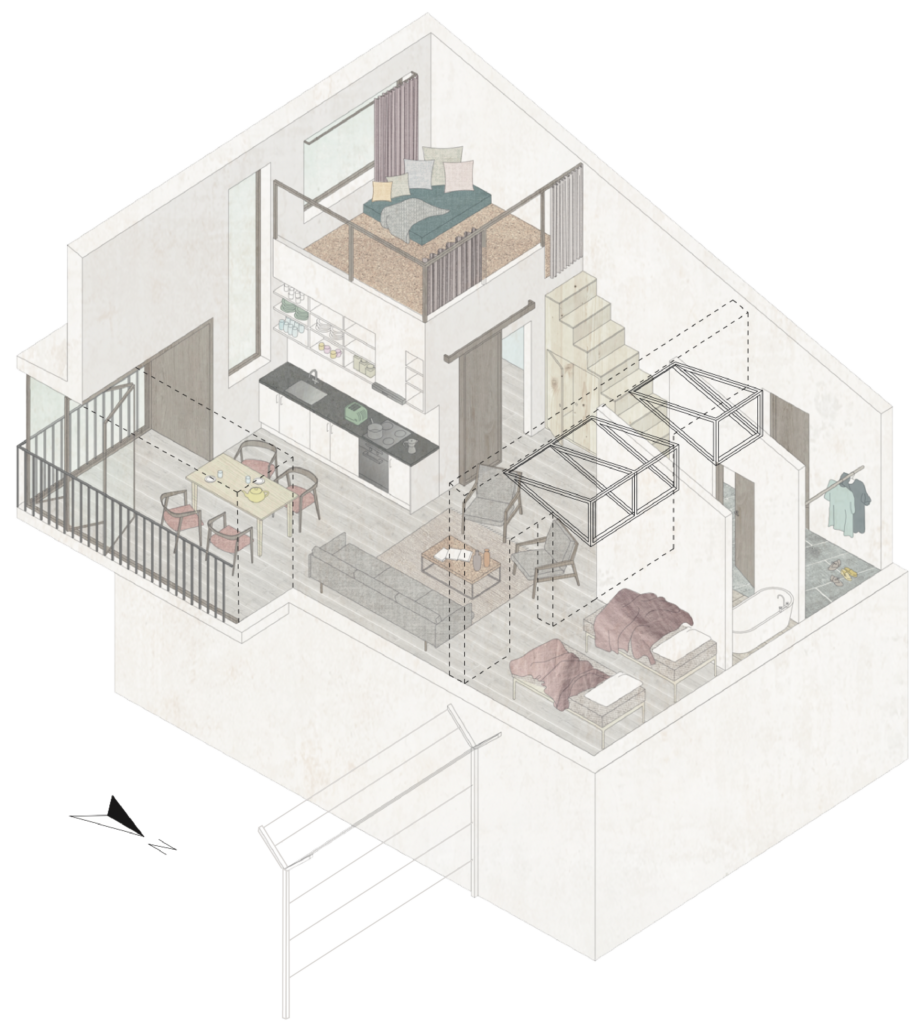
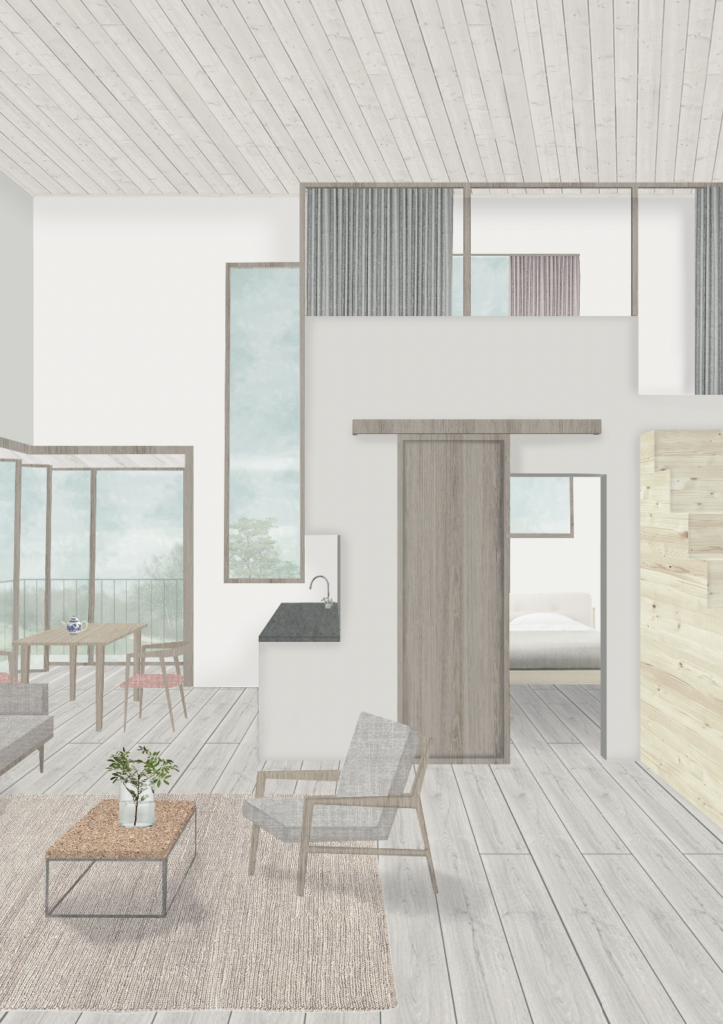
Common Room / Orangerie
On the second floor, there was the orangery – a common retreat room, where the inmates could take part in different activities. Or a space for two families to meet. Many of the inmate’s families and friends said that having someone in prison often made them feel like outsiders in society. With a place like this, it would be easier for these families to connect and find others in the same situation.
The orangery was one big room but it could be used as three separate rooms – divided visually by curtains. Either you could have three different activities going on at the same time, or you could use the orangery for one activity.
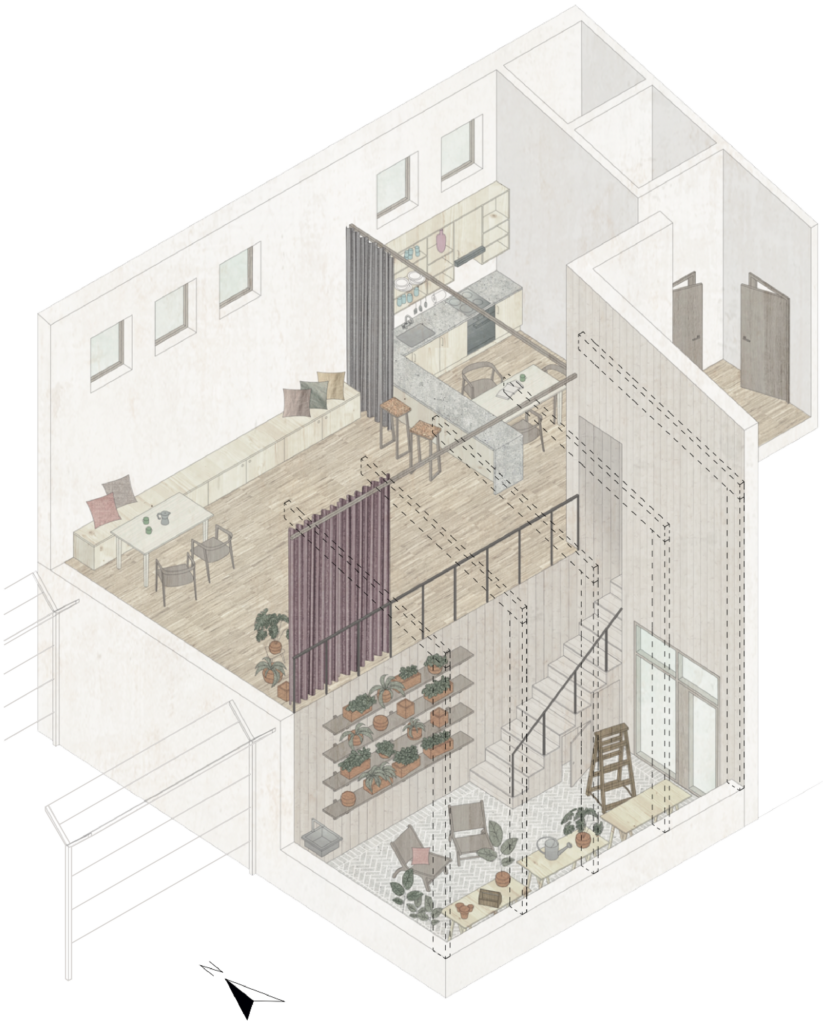
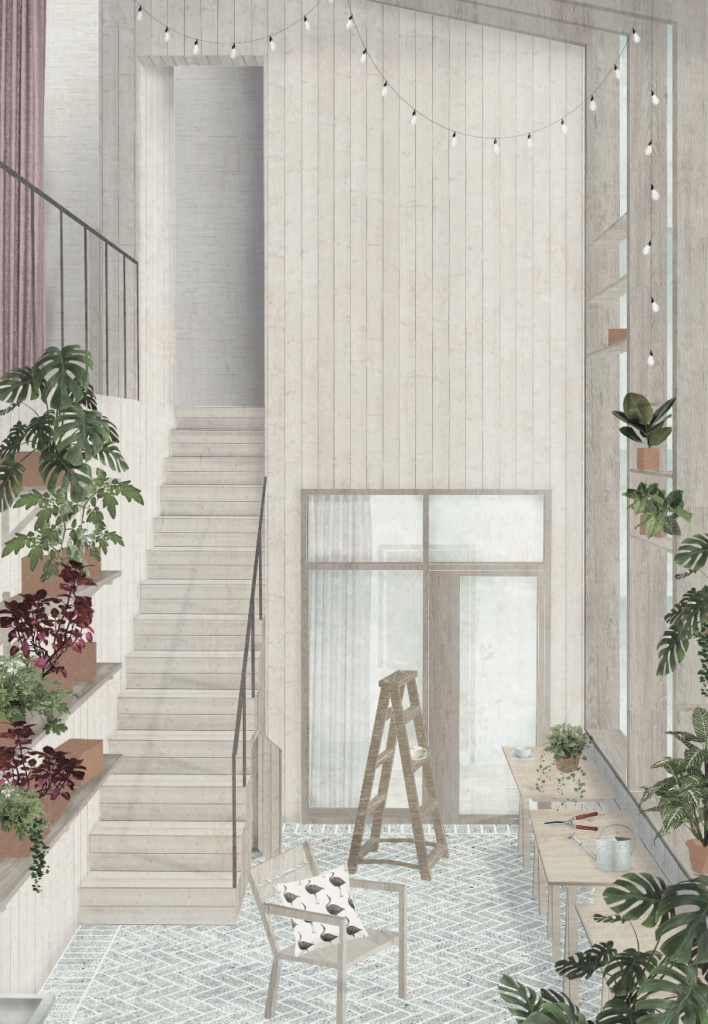
The purpose of this project was not to create a ”homelike-feeling” for the users. The purpose was rather to create a worthy stay for a broken family visiting a dad, a partner, a brother, or a friend. A worthy stay could mean having dinner on an extended balcony, reading a book together in a loft, or taking a bath while looking at the sky.
This building alone wouldn’t solve the problem of inmates relapsing in crime, but maybe it could make the visiting hours less anguished and the family ties to become a little bit closer.